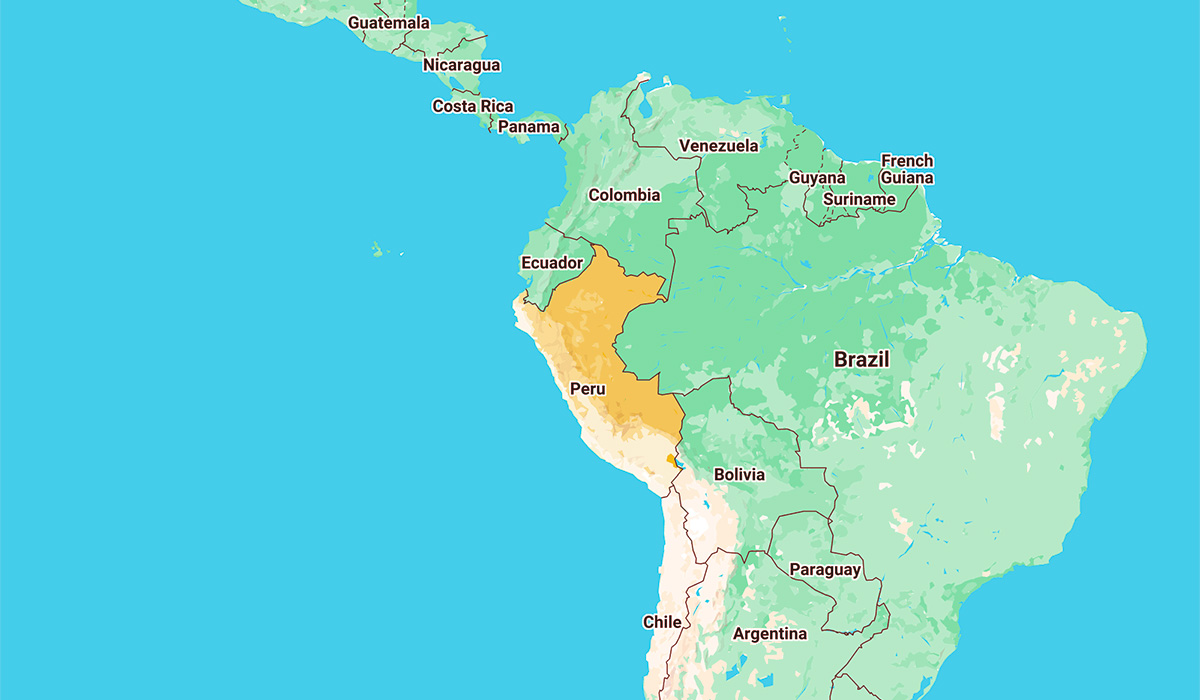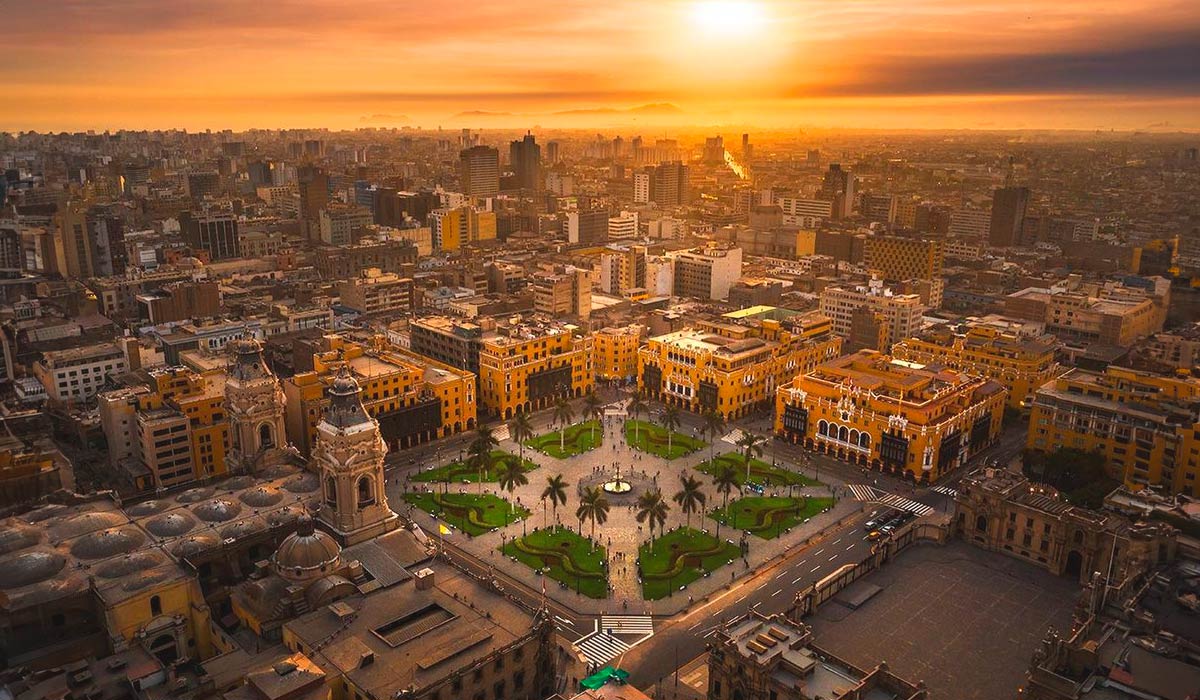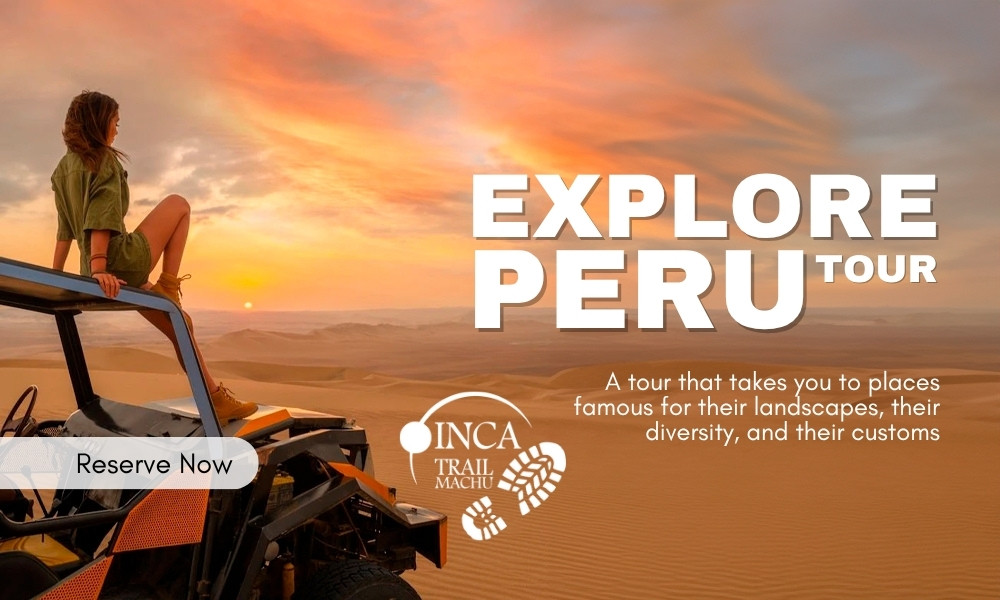
Lima is the capital of Peru and the largest and most populated city in the country. Located along the Pacific Ocean coast, it was founded by Francisco Pizarro in 1535 and established itself during the Viceroyalty as "The City of Kings", becoming the most important political and economic center in South America. Today, Lima is a vast metropolis that is home to more than 9 million inhabitants.
The city is recognized internationally for its extraordinary cultural offer and, in particular, for its gastronomy. Its fusion cuisine, which uses ingredients from the three geographical regions of the country (coast, highlands, and jungle), has established itself as the nation's main calling card, positioning it as one of the peruvian highlights. Furthermore, its historic center, with its colonial architecture, is a UNESCO World Heritage Site.
This guide will focus on breaking down the different historical stages of Lima, from its origins, to its current status as a metropolis. We will analyze its main tourist attractions and the logistical keys to travel to this place efficiently.
Where is Peru located?
The Republic of Peru is located in western South America. It is bordered by Ecuador and Colombia to the north; Brazil to the east; Bolivia to the southeast; Chile to the south; and the Pacific Ocean to the west.
The country has incredible biodiversity, from the arid plains of the Pacific coast to the peaks of the Andes and the Amazon rainforest. Peru is the 19th largest country in the world and the third largest country in South America. It is also home to ancient civilizations such as Caral, Mochica, Nazca, Chimú, and the great Inca Empire. Each of these great civilizations had their own capitals or major cities. Today, Peru is a multicultural country with many languages and ethnic races.
The most important cities in Peru, historically, are Cusco and Lima.

Where is the capital of Peru?
Lima, the capital of Peru, is located at an elevation of 528 feet (161 meters) in the central-western part of Peru. The city center is located about 8 miles (13 km) inland from the Pacific Ocean in the coastal desert of Peru.
While the “City of Kings” was initially founded on the banks of the Rimac River, today it extends across vast desert areas from north to south, including 11 rivers and many valleys. The city of Lima has grown so rapidly in the 1980s and 1990s due to immigration from the countryside and terrorism.
Today Lima is considered the fifth largest city in South America and the Caribbean countries, including Mexico.
Lima, the capital of Peru
The ancient capital of Peru, from the 14th to the 16th century, the Inca culture dominated most of South America. It was not just Peru; the Inca Empire, also known as Tawantinsuyo (the 4 provinces of the sun), dominated a vast territory from Colombia, Ecuador, Peru, Bolivia, Argentina, and northern Chile. Cusco was the center of this great empire and the most important city in South America. Today, Cusco holds the title of the historical capital of Peru.
Historical Facts of Lima Peru
- Initially, Lima was occupied by small civilizations from the coastal area of Peru; by the 15th century, the Inca Empire dominated the entire region.
- In 1532, the Inca king Atahualpa was captured in Cajamarca by Spanish conquistadors led by Francisco Pizarro.
- In April 1534, Francisco Pizarro founded the first capital of Peru in Jauja, a city located in the Andes with a warm and pleasant climate
- In December 1534, Francisco Pizarro ordered the transfer of all the treasures of Jauja to Lima, a city located near the sea and the main port of Callao.
- On January 18, 1533, Francisco Pizarro established the city of Lima (Ciudad de los Reyes) as the new capital of the Colony.
- On May 6, 1536, the rebellion of Manco Inca began. He sent Captain Quizo Yupanqui with his troops to besiege Lima. In September, the Inca troops arrived in Lima, where Captain Quizo Yupanqui was killed, and the Inca army retreated to the mountains.
- Francisco Pizarro was killed on June 26, 1541 by a group of people called Almagristas. They were led by Diego de Almagro el Mozo.
- On November 4, 1780, Tupac Amaru II (José Gabriel Condorcanqui) started the revolution in the Tinta Province of Cusco. He was executed in the Plaza del Cusco on July 19, 1783.
- On July 28, 1821, General José de San Martín proclaimed the famous Declaration of Independence in the Plaza Mayor of Lima.
- On January 17, 1881, Lima was occupied by the Chilean army during the War of the Pacific. Finally, on October 20, 1883, Peru and Chile signed the Treaty of Ancón; Peru ceded the province of Tarapacá to Chile. Antofagasta was forced to surrender by Bolivia
- Lima was the host of the 2019 Pan American Games, which were the largest sporting event the country has ever seen.

What are the main tourist attractions in Lima?
Pachacamac
Pachacamac is the largest and most important archaeological site in Lima, located in the district of Lurín. It has an area of 465.32 hectares with a perimeter of 12925.41 linear meters and is under the jurisdiction of the Ministry of Culture. It has a museum of the same name, with a collection of more than 6,500 pre-Hispanic pieces of various materials such as ceramics, wood, metal and textiles. One of the most emblematic pieces is the idol of Pachacamac.
Caral
It is located 182 kilometers north of Lima, in the province of Barranca. Due to its 5,000 years of history, it is the oldest civilization in Peru and the American continent, with an approximate age of 5,000 years. It is made up of 32 large buildings that are part of a complex system of settlements that display a strong religious ideology. These include impressive buildings for ceremonies, neighborhoods for different social classes, a set of small temples and workshops.
Larco Museum
The Larco Museum is a privately owned pre-Columbian art museum located in the Pueblo Libre district of Lima, Peru. The museum is housed in an 18th-century viceregal building. It displays galleries arranged in chronological order and can provide a comprehensive overview of Peru's 5,000-year-old pre-Columbian history. It is famous for its galleries of erotic pottery from the pre-Columbian era.
The Magic Water Circuit
The Magic Water Circuit symbolizes the restoration of Lima's public spaces. It features thirteen cybernetic fountains that use the most advanced technology to mix music, water, sound, and lasers into amazing and unique shows.
Plaza de Armas de Lima
The Plaza de Armas, or Plaza Mayor, is located in the historic center of Lima, surrounded by the Presidential Palace, the Lima Cathedral, the Archbishop's Palace, and other historic buildings.
Lima's main square is where José de San Martín declared Peru's independence on July 28, 1821.

Tours in and around Lima, the capital of Peru.
Lima City Tour:
You can explore the best of Lima's historic center on a half-day or full-day tour. We recommend hiring a tour company that will take you to downtown Lima by private transportation and allow you to explore with a local tour guide. You will visit Plaza San Martín, the San Francisco Convent Museum and Catacumbas, the Plaza de Armas (Plaza Mayor), the Larco Herrera Museum, and many other beautiful sites.
Swimming with Sea Lions at Palomino Island:
The Palomino Islands are located in the province of Callao. These famous tourist islands are home to a large population of sea lions and seabirds. To get to these islands, you must first travel to Callao, then travel by boat for 40 minutes to reach the area.
A Tour to Caral:
You will need a full day to visit Caral with a private van and a tour guide. First, you need to drive for 3.5 hours to the Supe Valley, where Caral is located. You can visit Huacho for lunch and visit the beach on the way back.
Culinary Tour:
Peru is one of the best culinary destinations worldwide, and Lima is home to some of the best restaurants in the world. Spend a beautiful morning exploring local markets and preparing the most famous Peruvian dishes such as ceviche.
Lima, Night City Tour + Magic Water Circuit:
You can tour Lima Center at night and visit the Magic Water Circuit.
Frequently Asked Questions about Lima – Peru
- What is the Location of Lima?
Lima, the capital of Peru, is located in the central part of the Pacific coast, flanked by coastal deserts, and extends to the valleys of the Chillón, Rimac and Lurín rivers. It covers an area of 2,672 km2 (1,031 sq mi).
- What is the average altitude of the city of Lima?
Lima is a city at sea level; the average altitude of the historic city center is 528 feet (161 meters).
- What is the population of Lima?
The population of Lima is now estimated at 9,751,717 inhabitants, including Metropolitan Lima and districts. The population density is 3000 people per kilometer or more than 7000 people per mile. This is equivalent to almost 30% of the Peruvian population.
- What is the predominant religion in Lima?
The dominant religion is Christianity. However, Peru is traditionally associated with religious fusion, originating from Catholicism and the ancient Incan religion after the Spanish conquest. It is also becoming common for Judaism, Buddhism, Hinduism, and Islam due to immigration in recent years.
- What is the climate of Lima?
Although Lima is in the tropics and in the desert, it has a temperate climate because it is close to the Pacific Ocean.
During the summer, from December to April, the daily temperature varies from 18°C (64°F) to 22°C (72°F) and from 24°C (75°F) to 29°C (84°F). During this time of year, the days are sunny and warm.
During winter, from June to October, temperatures range from 14 °C (57 °F) to 16 °C (61 °F), with the minimum being 14 °C (57 °F) and the maximum being 16 °C (61 °F) to 19 °C (66 °F). The sky is often grey during this time, with morning drizzle and high humidity.
May and November are transitional months where we see sudden changes in the weather.
- What is the main currency in Lima?
The main currency in Peru is Nuevos Soles; in most local markets and shops, you will use only soles. However, banks will allow you to make transactions in soles or USD. Car, house and real estate transactions are always made in USD.
- What is the main population of Lima?
The population of Lima is made up of several ethnic groups. The largest groups are mestizos, Europeans (descendants of Spaniards, Germans, Italians and French), Afro-Peruvians and Asians (China and Japan).
Thanks to this complex mix of racial and ethnic groups, Peru is now one of the best culinary destinations in the world. Chinese and Italian cuisine has helped create unique Peruvian dishes.
- How to get to Lima?
→ By Land: The Pan-American Highway crosses the country from south to north, connecting with all the cities in the coastal area and other countries such as Chile in the south and Ecuador in the north. We also have access to highways in the east that connect us with the cities of the Andes and the jungle of Peru.
→By Air: From the Jorge Chávez International Airport of Peru, located in the province of Callao, 30 minutes from the center of Lima. You can take flights to any city in Peru or any other country.
- The best way to travel from Lima to Cusco
The best and fastest way to travel from Lima to Cusco and vice versa is by taking a flight from Jorge Chavez Airport in Lima to Alejandro Velasco Astete Cusco. The duration is approximately 1 hour flight.
For travelers who like to explore the country more, they can take a bus from Lima via Abancay to Cusco with a duration of 20 hours. Also, take a bus from Lima via Arequipa to Juliaca with a bus ride of 24 hours.
Best Tours in Peru
Peru offers fascinating experiences that reveal natural landscapes, historical monuments, and living cultures, captivating those who seek adventure and discovery in every corner of its territory. Get to know the most outstanding tours:
Other trips in Peru
If you want to visit Machu Picchu, we recommend you to book your Machu Picchu Entrance Tickets in advance, so you will enjoy your Vacation in Machu Picchu without any problem.
